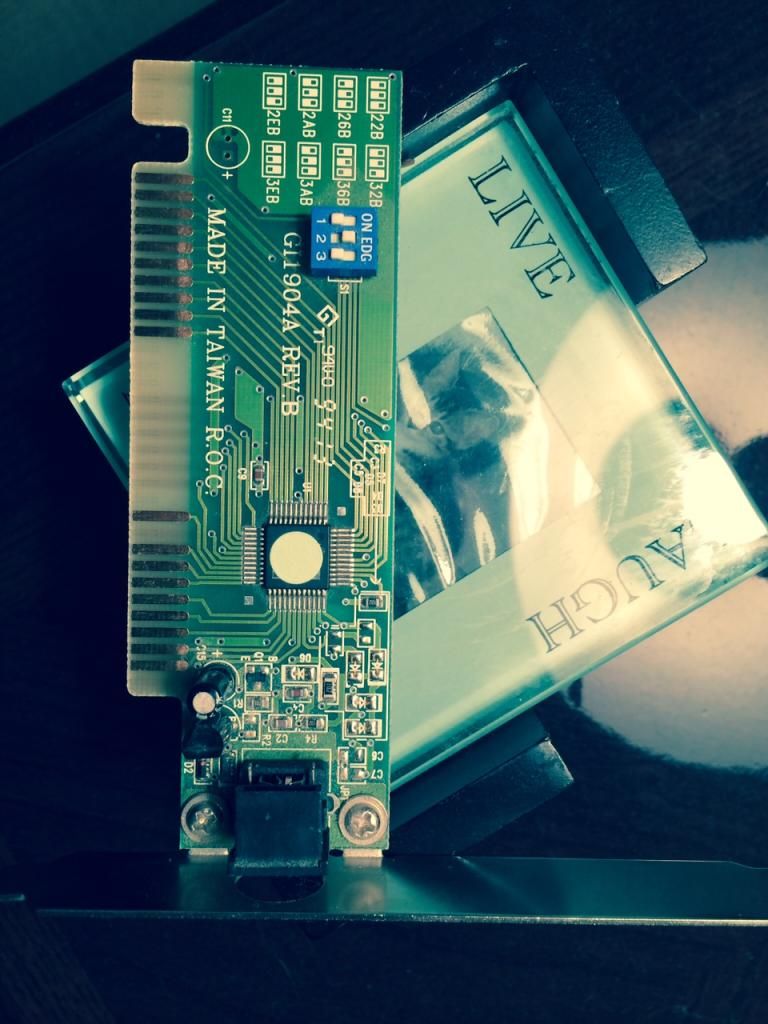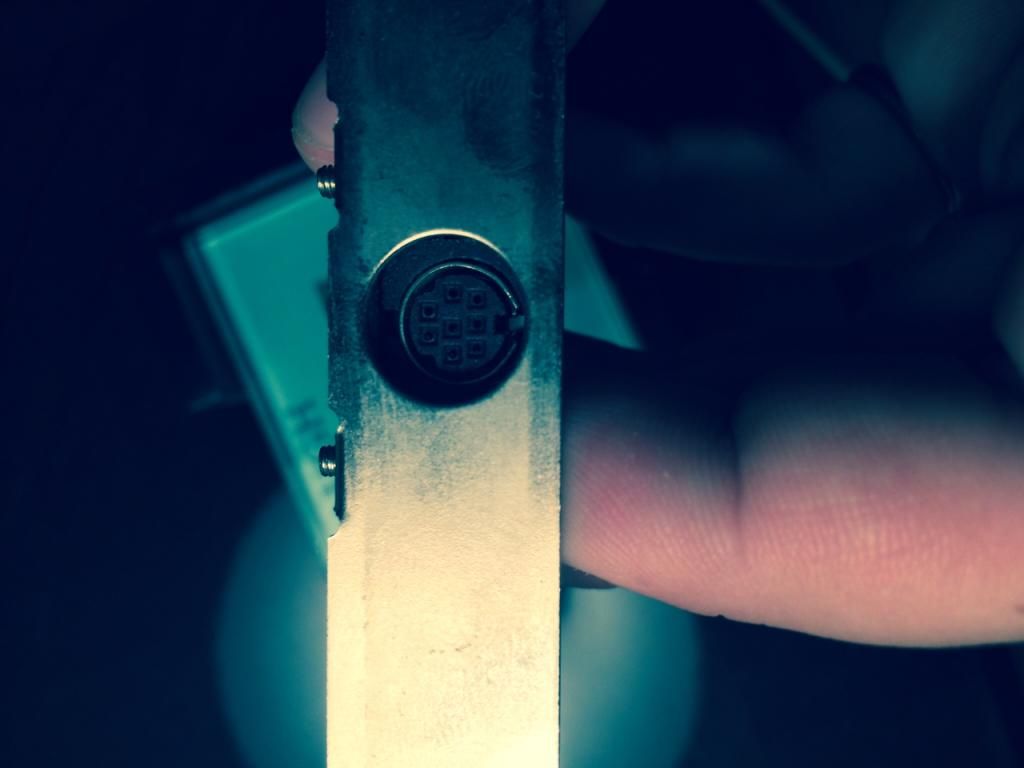Upcoming Events:
- VCF South West - June 14 - 16, Davidson-Gundy Alumni Center at University of Texas at Dallas
- VCF West - Aug 2 - 3, Computer History Museum, Mountain View, CA
- VCF Midwest - Sept 7 - 8 2024, Schaumburg, IL
- VCF SoCal - Mid February 2025, Location TBD, Southern CA
- VCF East - April 2025, Infoage Museum, Wall NJ
-
Please review our updated Terms and Rules here
You are using an out of date browser. It may not display this or other websites correctly.
You should upgrade or use an alternative browser.
You should upgrade or use an alternative browser.
Assistance With an ISA Card
- Thread starter Smack2k
- Start date
Smack2k
Veteran Member
Should I even keep it? Does it have any value? I saw them online for like 50 bucks...is that right?
Well, if it is what I said (wait for somebody else to confirm it), it can only be used with the scanner model that it was sold with.
If the seller asks for $50 (s)he expects to find a scanner owner whose card has been lost or broken... and (s)he expects the owner will prefer to keep the old scanner instead of buying a newer and better one. In other words: somebody from this forum
I have two of them (not the same exact model, but 2 scanner interfaces without the scanner "partner"). Their use is instructive: I show them to young people who has never seen an ISA card.
If the seller asks for $50 (s)he expects to find a scanner owner whose card has been lost or broken... and (s)he expects the owner will prefer to keep the old scanner instead of buying a newer and better one. In other words: somebody from this forum
I have two of them (not the same exact model, but 2 scanner interfaces without the scanner "partner"). Their use is instructive: I show them to young people who has never seen an ISA card.
Smack2k
Veteran Member
Thanks for the info...
The card is an interface to Omron 1700 scan head grayscale handheld scanners. The most popular ones were sold as the Logitech Scanman. Interface cards were available on many platforms, including the Apple II where it was sold as the Vitesse Quickie.
Smack2k
Veteran Member
Appreciate the help...
Guess it will go in teh bin
Guess it will go in teh bin
Other ISA cards to identify
Other ISA cards to identify
Hello,
I have the same problem with some other cards so I decided to recycle the thread:
this one looks like a video card but I have no idea.. it has a DB-9 connector and 2 RCA lookalike connectors, nothing is printed on the back
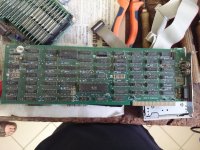
this one looks like a floppy controller but I am not sure.. when connected to a 3.5 1.44mb or 5 1/4 1.2mb the bios says floppy controller error.. if anyone can identify the card I could search for it's jumper configuration..
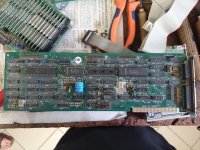
this one is a floppy and mfm controller but it looks like it has some daughter board on it.. I could use it as a floppy controller but I do not have a working mfm drive to test the rest.. it has many jumpers on it and I'd like to discover how to configure them.. it also has led display and a push button on top
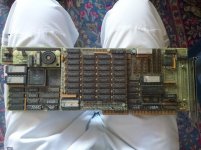
Other ISA cards to identify
Hello,
I have the same problem with some other cards so I decided to recycle the thread:
this one looks like a video card but I have no idea.. it has a DB-9 connector and 2 RCA lookalike connectors, nothing is printed on the back

this one looks like a floppy controller but I am not sure.. when connected to a 3.5 1.44mb or 5 1/4 1.2mb the bios says floppy controller error.. if anyone can identify the card I could search for it's jumper configuration..

this one is a floppy and mfm controller but it looks like it has some daughter board on it.. I could use it as a floppy controller but I do not have a working mfm drive to test the rest.. it has many jumpers on it and I'd like to discover how to configure them.. it also has led display and a push button on top

phil_s
Member
A video card with a DE-9 and two RCA connectors is usually an EGA card. But this is missing the LSI chips, DIP switches and feature connector that almost all EGA cards have. I can't see any oscillators which implies it is a CGA-compatible card using the OSC signal from the ISA connector. If this is the case then the large central chip will be a 6845 variant. I have seen a CGA card with two RCA sockets in the past - if I remember correctly the second one output an NTSC signal (RS-170?)
GottaLottaStuff
Veteran Member
The second one looks like a MFM or RLL controller. What are the conectors on the edge? Serial and parallel? The third looks like the CPU card from a backplane system. What does the print one the big square chip say? Those four rows of eight chips look like ram, what size are they?
SomeGuy
Veteran Member
The second one is a generic full-length Taiwanese multi-io card for 8-bit XT systems. I have one almost just like it. The headers are 360k/720k FDC, COM 2, COM 1 (both for large DB-25 backplate connectors) and ones the end are a joystick port and parallel port. It also has an integrated real time clock, accessible with commonly available XT clock drivers. To use COM 2 you would need to add a second UART and line driver chips.
Not sure exactly what all the jumpers are specifically, but they would select the parallel as LPT1 or LPT2, and the com ports as COM1/2, COM2/3, COM3/4, or COM 4.
That last one is very, very unusual. It sort of looks like a CPU card, (is that socketed chip a CPU? What does it say on it?) but it looks like it has an integrated FDC and MFM or RLL controller, so it could be some really fancy smart hard drive controller with a pile of hardware RAM cache.
Not sure exactly what all the jumpers are specifically, but they would select the parallel as LPT1 or LPT2, and the com ports as COM1/2, COM2/3, COM3/4, or COM 4.
That last one is very, very unusual. It sort of looks like a CPU card, (is that socketed chip a CPU? What does it say on it?) but it looks like it has an integrated FDC and MFM or RLL controller, so it could be some really fancy smart hard drive controller with a pile of hardware RAM cache.
Last edited:
hello everyone, thanks for your replies, the first one I immagined it was a video card even if I have no way of testing it right now..
as for the second one I confirm it is not an mfm or rll controller because the small headers have 26 pin so more than those required for mfm... (sorry for the LQ pics) probabily they are COM ports like suggested by SomeGuy.. and, to SomeGuy: I am waiting for an ibm xt I got off ebay so this card can be usefull, do you know where I could get the appropriate driver for having the realtime clock? Is there anything special I should know about?
as for the third card the socketed cpu is a motorola MC68000FN8, I have taken some more detailed pics of the main chips without what appears to be the ram block and of the block itself (for GottaLottaStuff, I have no idea what is their size but I hope the pictures will help)
oh, I forgot, the print on the card says "Distributed Processing Technology", searching on google I found it was usual for these cards to have the small led display and the push button even if I could not find their pourpose
here are some pics:
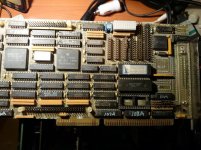
View attachment 19951
As attaching pictures reduces their size I uploaded an archive to my dropbox with all the pictures inside at their native resolution and readable chip numbers (sorry, I know that it is boring to download and uncopress)
https://www.dropbox.com/s/pp81x3defmjuw2v/strange_cards.zip
as for the second one I confirm it is not an mfm or rll controller because the small headers have 26 pin so more than those required for mfm... (sorry for the LQ pics) probabily they are COM ports like suggested by SomeGuy.. and, to SomeGuy: I am waiting for an ibm xt I got off ebay so this card can be usefull, do you know where I could get the appropriate driver for having the realtime clock? Is there anything special I should know about?
as for the third card the socketed cpu is a motorola MC68000FN8, I have taken some more detailed pics of the main chips without what appears to be the ram block and of the block itself (for GottaLottaStuff, I have no idea what is their size but I hope the pictures will help)
oh, I forgot, the print on the card says "Distributed Processing Technology", searching on google I found it was usual for these cards to have the small led display and the push button even if I could not find their pourpose
here are some pics:

View attachment 19951
As attaching pictures reduces their size I uploaded an archive to my dropbox with all the pictures inside at their native resolution and readable chip numbers (sorry, I know that it is boring to download and uncopress)
https://www.dropbox.com/s/pp81x3defmjuw2v/strange_cards.zip
krebizfan
Veteran Member
DPT made a lot of caching SCSI controllers. The third card looks like a caching controller but not SCSI; probably ESDI. The online copies of PC Magazine has a picture of a PM3011/75 which looks very similar. See page 169 of June 12, 1990. Looks like your card has the 2MB daughtercard and the disk mirroring options. The card will support 4 ESDI drives which will use 2 of the 34 pin connectors but there is what looks like a third 34 pin connector for floppy usage. Need manual to correctly setup all drives.
I hope this link works for you http://books.google.com/books?id=u7...ed=0CCwQ6AEwAA#v=onepage&q=pm 3011/75&f=false
I hope this link works for you http://books.google.com/books?id=u7...ed=0CCwQ6AEwAA#v=onepage&q=pm 3011/75&f=false
hello krebizfan,
thanks for your answer, yes probably you are right, looks the same as the one on the magazine you mentioned! What the more I can say mfm connecotrs suit perfectly on the card, this made me think it was mfm! as I do not have an ESDI hdd I cannot test, the other connector as you said is for floppy and appears to work!
thanks for your answer, yes probably you are right, looks the same as the one on the magazine you mentioned! What the more I can say mfm connecotrs suit perfectly on the card, this made me think it was mfm! as I do not have an ESDI hdd I cannot test, the other connector as you said is for floppy and appears to work!

